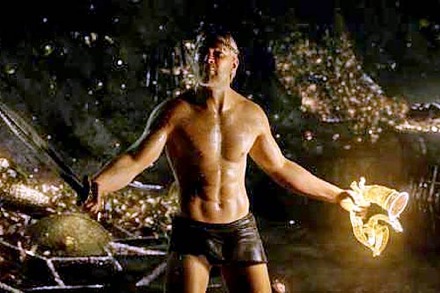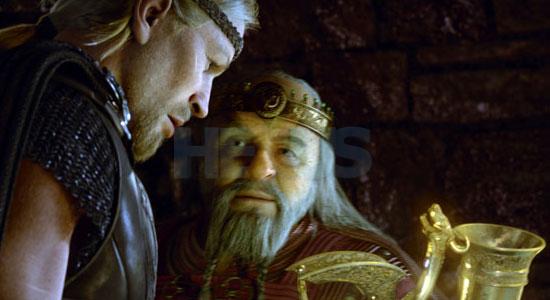 Some individuals are perfectly happy to get through a day and accomplish all that they set out to do, however simple or far-reaching those goals may be. I admire these folks, but I am not one of them. Chores, errands, and daily rituals, while admittedly necessary for one's own sanity, often prevent me from doing all the things I want to do. The problem is, I'm not sure exactly what it is I need to be doing. Getting out more, living more, seeing more, etc. (Key word here is "more", for those who haven't picked up on my bloated sense of self-importance). There is no set list of things I want or need to do; it's all very cluttered, and most usually ambiguous to my own identification. It's nice to experience Big and Profound things, but I also like to sit at a diner and eat a delicious omelet, or stop off on some random exit on an interstate highway and see the lived-in world around me. There is as much richness and poetry in seemingly mundane experiences/destinations as in the stereotypically fulfilling ones, sometimes more. I guess I see a little of Jack Kerouac in me, or at least I wish. I could travel the world and meet thousands of different people and still feel like I need to see more. But when I become so bogged down by the simple tasks of day-to-day experience, as we all do to varying degrees, watching a movie can be downright therapeutic. I suppose it's only therapeutic when I forget how absolutely necessary it is to have a quiet outlet as a break from the busyness of daily ritualizing. Nevertheless, it's downright essential. I forget this quite frequently, only to re-learn it again in new ways.
Some individuals are perfectly happy to get through a day and accomplish all that they set out to do, however simple or far-reaching those goals may be. I admire these folks, but I am not one of them. Chores, errands, and daily rituals, while admittedly necessary for one's own sanity, often prevent me from doing all the things I want to do. The problem is, I'm not sure exactly what it is I need to be doing. Getting out more, living more, seeing more, etc. (Key word here is "more", for those who haven't picked up on my bloated sense of self-importance). There is no set list of things I want or need to do; it's all very cluttered, and most usually ambiguous to my own identification. It's nice to experience Big and Profound things, but I also like to sit at a diner and eat a delicious omelet, or stop off on some random exit on an interstate highway and see the lived-in world around me. There is as much richness and poetry in seemingly mundane experiences/destinations as in the stereotypically fulfilling ones, sometimes more. I guess I see a little of Jack Kerouac in me, or at least I wish. I could travel the world and meet thousands of different people and still feel like I need to see more. But when I become so bogged down by the simple tasks of day-to-day experience, as we all do to varying degrees, watching a movie can be downright therapeutic. I suppose it's only therapeutic when I forget how absolutely necessary it is to have a quiet outlet as a break from the busyness of daily ritualizing. Nevertheless, it's downright essential. I forget this quite frequently, only to re-learn it again in new ways.Lately, I've had a build-up of schedules, "to do" lists, and all those random things that pop up and conveniently require a great deal of attention. While I've accepted there to be a certain amount of this in my life, which is probably a good thing, my tolerance for these chores begins to wane when it occupies the majority of my time in a given stretch. Regular movie watching has been down as a result; what little of it I've done has been 20 minutes here, 40 minutes there. But it's absolutely critical that I squeeze in those little bits of movie-watching, no matter the kind of movie, because sometimes the right movie at the right (or wrong) time is just what I need. Of course, it's impossible to know it until I've seen it and internalized it. You never know when that therapeutic experience of cinema will sneak up. Some of these movies just take your mind off things, providing necessary reprieve and absurdity to counter all the reality of life. Others penetrate the very depths of your consciousness, impacting how you view and partake in all of those daily rituals. Sometimes they can even help one to appreciate those pesky errands, schedules, and jobs a little more.
Here's about the point where I narcisitically mention my own experience with cinema therapy. The movie is Ramin Bahrani's Man Push Cart (2006), which I've been waiting to watch for quite some time. I saw it under the most thankless of circumstances, squeezing it in where I could over the course of a few days, but finally having the chance to take in most of its running time after several attempts. It's an easy film to admire purely on "technical" grounds. (I place quotations on the word, technical, after having read Jim Emerson's recent post concerning the petty way so many critics understand and employ terms like "technical" and "style".) But there is something so intangible about seeing this quiet, simple story unfold before me in such perfect detail, i.e. involving me in both the internal experience of its central character as well as the environment (New York City) within which he lives and works anonymously, cut right into me. It captures that world so effectively -- all the cars, trucks, and people swooping by at brisk pace, unable to see each other or connect. More importantly, it captures the feeling of complete insignificance as a member of that world; the feeling of being the tiniest cog in the massive web of society unfolding around you.
But the film is anything but cynical or depressing. Even though we never quite learn about Ahmad's tragedy, who quietly moves about the city every day in his push cart, there is a profound sense of existential aching to the proceedings that's captured in every movement of the camera and every sound of a vehicle driving by. Existentialism is not really about misery anyway, but about how to live with one's choices and take responsibility for them. Quite simply, it's about the choices one makes regarding how to exist in the world out there.
Often times in the movies, or stories in general, we play witness to the "drama" of the characters' lives. There is a tidy beginning, middle, and end so as to enable our pleasure, like we experienced the dramatic arc with the characters. People go through highs and lows, and learn something in the end, where themes culminate and the narrative takes on a particular significance to the reader/viewer/critic. But often times the most honest of films are the ones that can capture the everyday motion and ritualizing of someone's life other than your own (in a non-creepy way of course). Cinema is a powerful aesthetic expression because it can transcend boundaries of narrative and capture organic life, right down to the most seemingly mundane of details. Its visualization of nearly any abstraction or connection enacts an ambiguity of perspective that defines the richness of lived experience.
Man Push Cart, like another favorite film of mine, Lost In Translation, captures an exact moment of a person's life. We can't get inside his head; his expressions don't communicate pre-packaged emotions such as "anger", "rage", or "jealousy", and the manner in which his life is portrayed does not follow the dramatic archs of most storytelling. We have a man, his interactions with those around him. Even though we cannot peer into his thoughts in the same way we can observe his everyday actions, the portrayal of his small place in the larger world around him ultimately becomes the gateway into his innermost dreams, thoughts, and frustrations. That's because he is doing what we are all doing; existing. Getting through each day. His thoughts and passions may differ from yours and mine. They probably don't always make sense or connect in ways that typical narratives tend to present. But the expression in his eyes and face represent everything that he is, everything he is not, and everything he wants to be.









